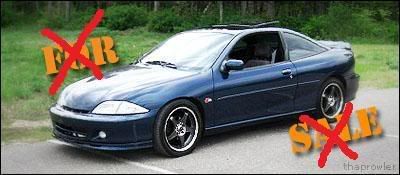befor i spend money on getting the block work done i need to know if it works or not
no 2.2 is 97 and 2200 is 98
im planning on having a fully built forged bottom end. plus i already have the 97 block from my 97 rs i totaled last year
well the crank is even the same i used a 97 2.2 block in my 98 2200 car because i couldnt find one around me i just changed the pistons and head and called it good it was just a daily driver but i didnt have any problems

my kill list:a geo metro and a mac semi wow did i kill that thing
definitely have to use the 2200 pistons and head, but the block should be the same.
GL getting a forged crank BTW, forged rods are always good though.

Home jBP Team 2nd Gen Products 3rd Gen Products Cobalt/Redline/HHR/G5 Solstice/Sky Customer Cars Contact us
Part Details JP0412
JP0412 - JBP 4340 Forged Steel 84mm Crankshaft
Price: [$1320 (US$1108.80)]
Finally, a crankshaft available for serious modifications. Our forged crankshaft is absolutely revolutionary. The first thing that comes to mind with forged cranks are the ability to withstand large amounts of power, (before they exceed their yield stress). Our crank is the not only forged steel. But also fully customizable. Journal diameters have been made in such a way that you can offset grind the crank to gain a larger stroke. (Additional Fee) Our forged crank also has a customizable crankshaft position sensor timing ring. With this we have the ability to advance your timing right off the crankshaft. You tell us that you want to advance the timing 2degrees, consider it done. Our forged crankshaft is made from 4340 forged steel and is knife edged. So for those worrying about bottom end stability, worry no more. With the customizable nature of our forged crankshaft and all the options available for aftermarket rods, jbody enthusiasts now have that performance edge that only JBP can provide.
Buy Now
jBody Performance Inc. © 2000-2008
should i get this crank or should i stick with my stock crankthen im new to building motors i just figured since it was forged it would hold up to what my plans for the car
larry stutler wrote:Home jBP Team 2nd Gen Products 3rd Gen Products Cobalt/Redline/HHR/G5 Solstice/Sky Customer Cars Contact us
Part Details JP0412
JP0412 - JBP 4340 Forged Steel 84mm Crankshaft
Price: [$1320 (US$1108.80)]
Finally, a crankshaft available for serious modifications. Our forged crankshaft is absolutely revolutionary. The first thing that comes to mind with forged cranks are the ability to withstand large amounts of power, (before they exceed their yield stress). Our crank is the not only forged steel. But also fully customizable. Journal diameters have been made in such a way that you can offset grind the crank to gain a larger stroke. (Additional Fee) Our forged crank also has a customizable crankshaft position sensor timing ring. With this we have the ability to advance your timing right off the crankshaft. You tell us that you want to advance the timing 2degrees, consider it done. Our forged crankshaft is made from 4340 forged steel and is knife edged. So for those worrying about bottom end stability, worry no more. With the customizable nature of our forged crankshaft and all the options available for aftermarket rods, jbody enthusiasts now have that performance edge that only JBP can provide.
Buy Now
I don't see anywhere where it says this crank is for the 2.2 or the 2200. Sounds like a total waste of money anyhow.
jBody Performance Inc. © 2000-2008

FORGET GIRLS GONE WILD WE HAVE GOVERNMENT SPENDING GONE WILD!




